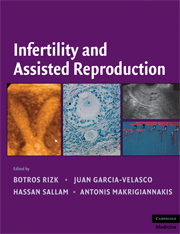Book contents
- Frontmatter
- Contents
- Contributors
- Foreword
- Preface
- Introduction
- PART I PHYSIOLOGY OF REPRODUCTION
- PART II INFERTILITY EVALUATION AND TREATMENT
- PART III ASSISTED REPRODUCTION
- 38 Medical Strategies to Improve ART Outcome: Current Evidence
- 39 Surgical Preparation of the Patient for In Vitro Fertilization
- 40 IVF in the Medically Complicated Patient
- 41 Polycystic Ovary Syndrome and IVF
- 42 Endometriosis and Assisted Reproductive Technology
- 43 Evidence-Based Medicine Comparing hMG/FSH and Agonist/Antagonist and rec/Urinary hCG/LH/GnRH to Trigger Ovulation
- 44 Luteal Phase Support in Assisted Reproduction
- 45 Thrombophilia and Implanation Failure
- 46 Intrauterine Insemination
- 47 The Prediction and Management of Poor Responders in ART
- 48 Oocyte Donation
- 49 In Vitro Maturation of Human Oocytes
- 50 Oocyte and Embryo Freezing
- 51 Cryopreservation of Male Gametes
- 52 The Management of Azoospermia
- 53 Spermatid Injection: Current Status
- 54 Optimizing Embryo Transfer
- 55 Single Embryo Transfer
- 56 Blastocyst Transfer
- 57 Clinical Significance of Embryo Multinucleation
- 58 Quality and Risk Management in the IVF Laboratory
- 59 The Nurse and REI
- 60 Understanding Factors That Influence the Assessment of Outcomes in Assisted Reproductive Technologies
- 61 The Revolution of Assisted Reproductive Technologies: How Traditional Chinese Medicine Impacted Reproductive Outcomes in the Treatment of Infertile Couples
- 62 Complications of Assisted Reproductive Technology
- 63 Ectopic and Heterotopic Pregnancies Following in Vitro Fertilization
- 64 The Impact of Oxidative Stress on Female Reproduction and ART: An Evidence-Based Review
- 65 PGD for Chromosomal Anomalies
- 66 Preimplantation Genetic Diagnosis for Single-Gene Disorders
- 67 Epigenetics and ART
- 68 Congenital Anomalies and Assisted Reproductive Technology
- PART IV ETHICAL DILEMMAS IN FERTILITY AND ASSISTED REPRODUCTION
- Index
- Plate section
- References
67 - Epigenetics and ART
from PART III - ASSISTED REPRODUCTION
Published online by Cambridge University Press: 04 August 2010
- Frontmatter
- Contents
- Contributors
- Foreword
- Preface
- Introduction
- PART I PHYSIOLOGY OF REPRODUCTION
- PART II INFERTILITY EVALUATION AND TREATMENT
- PART III ASSISTED REPRODUCTION
- 38 Medical Strategies to Improve ART Outcome: Current Evidence
- 39 Surgical Preparation of the Patient for In Vitro Fertilization
- 40 IVF in the Medically Complicated Patient
- 41 Polycystic Ovary Syndrome and IVF
- 42 Endometriosis and Assisted Reproductive Technology
- 43 Evidence-Based Medicine Comparing hMG/FSH and Agonist/Antagonist and rec/Urinary hCG/LH/GnRH to Trigger Ovulation
- 44 Luteal Phase Support in Assisted Reproduction
- 45 Thrombophilia and Implanation Failure
- 46 Intrauterine Insemination
- 47 The Prediction and Management of Poor Responders in ART
- 48 Oocyte Donation
- 49 In Vitro Maturation of Human Oocytes
- 50 Oocyte and Embryo Freezing
- 51 Cryopreservation of Male Gametes
- 52 The Management of Azoospermia
- 53 Spermatid Injection: Current Status
- 54 Optimizing Embryo Transfer
- 55 Single Embryo Transfer
- 56 Blastocyst Transfer
- 57 Clinical Significance of Embryo Multinucleation
- 58 Quality and Risk Management in the IVF Laboratory
- 59 The Nurse and REI
- 60 Understanding Factors That Influence the Assessment of Outcomes in Assisted Reproductive Technologies
- 61 The Revolution of Assisted Reproductive Technologies: How Traditional Chinese Medicine Impacted Reproductive Outcomes in the Treatment of Infertile Couples
- 62 Complications of Assisted Reproductive Technology
- 63 Ectopic and Heterotopic Pregnancies Following in Vitro Fertilization
- 64 The Impact of Oxidative Stress on Female Reproduction and ART: An Evidence-Based Review
- 65 PGD for Chromosomal Anomalies
- 66 Preimplantation Genetic Diagnosis for Single-Gene Disorders
- 67 Epigenetics and ART
- 68 Congenital Anomalies and Assisted Reproductive Technology
- PART IV ETHICAL DILEMMAS IN FERTILITY AND ASSISTED REPRODUCTION
- Index
- Plate section
- References
Summary
SAFETY OF ART
Assisted reproductive technologies (ART) are increasingly used worldwide to overcome infertility problems, and it has been estimated that more than one million children have been born relying on these techniques. ART births now account for 1–3 percent of all births in developed countries. ART have considerably evolved since the beginning, and now they include controlled ovarian stimulation, (immature) gamete retrieval and manipulation, standard in vitro fertilization (IVF), intracytoplasmic sperm injection (ICSI), (extended) embryo culture, freezing/thawing of embryos, embryo biopsy in cases of preimplantation genetic diagnosis, and more recently in vitro maturation of oocytes and techniques of cryopreservation of testicular/ovarian tissues. There has been concern about the health of the children conceived ever since the birth of the first IVF baby in 1978 (1) and certainly after the introduction of the more invasive ICSI procedure in the early 1990s. The safety aspect has been addressed in various epidemiological studies of children conceived by ART as well as experimental studies. The follow-up studies including a review by Rizk et al. of the major congenital anomalies in the first 1,000 babies conceived by IVF have shown that generally ART-conceived children are as healthy as naturally conceived children (1), except that ART may increase the risk of a few outcomes. There is accumulating evidence of an increase in chromosomal abnormalities in ICSI children, as well as evidence for an increase in malformation rate and in the number of singleton children with a low birth weight in the IVF/ICSI population compared to the general population.
Keywords
- Type
- Chapter
- Information
- Infertility and Assisted Reproduction , pp. 677 - 683Publisher: Cambridge University PressPrint publication year: 2008



